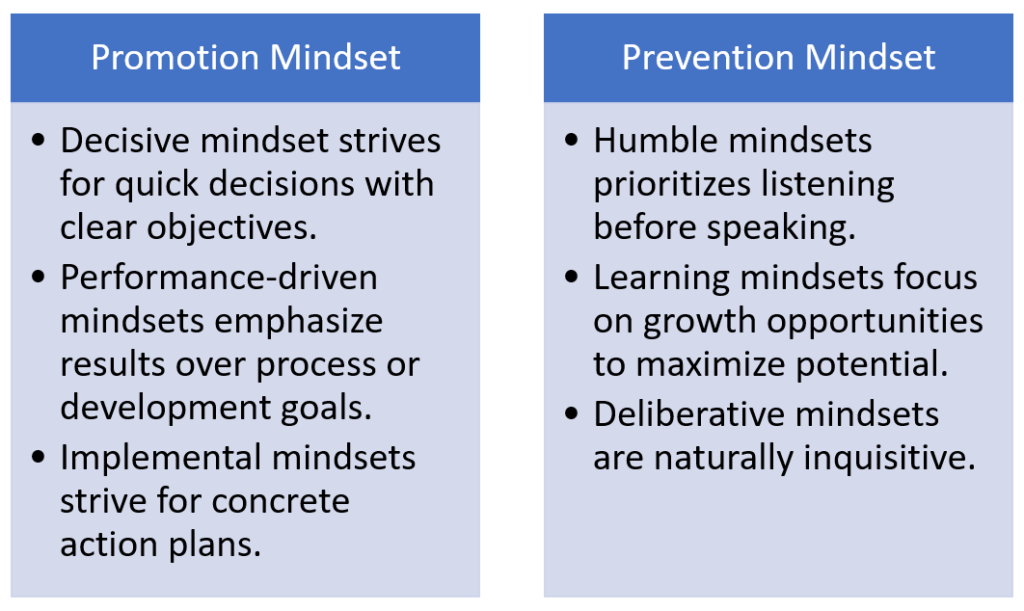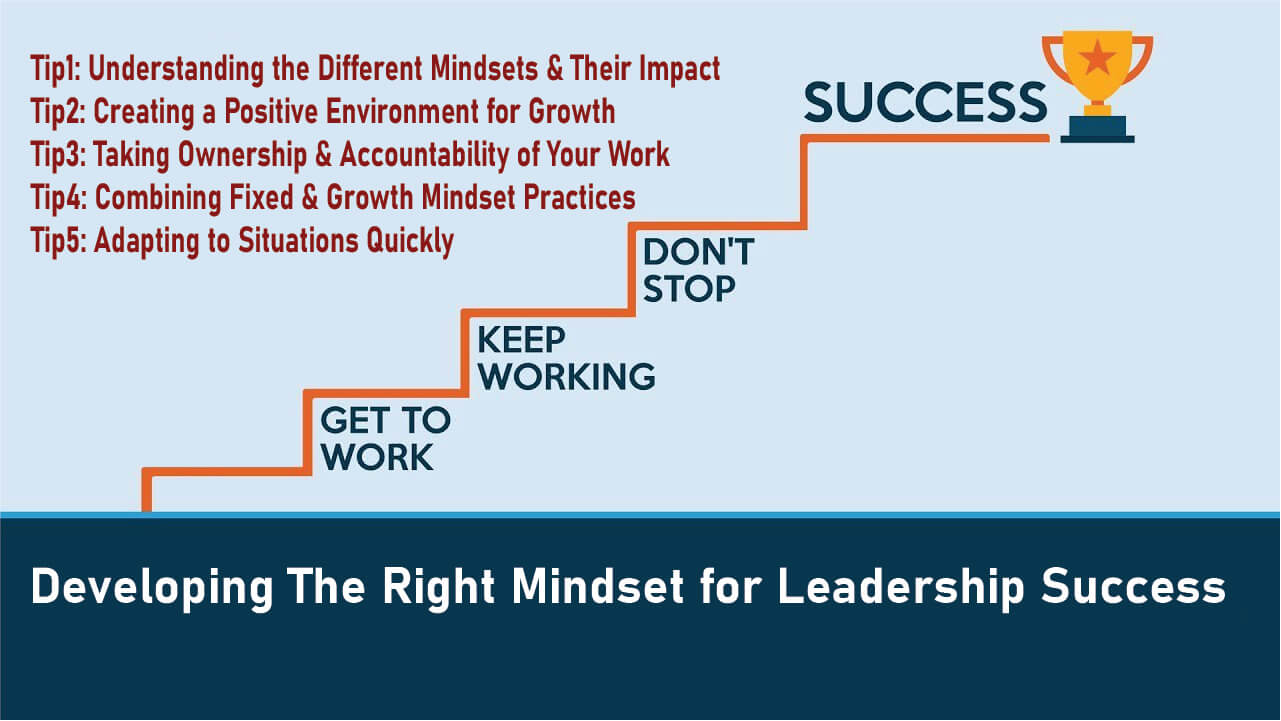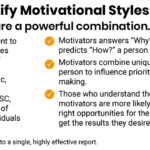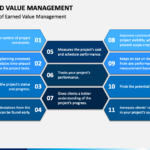Are you ready to take your business beyond just great ideas? Success requires a clear vision, openness to feedback, and accountability. It will pay off in droves if you have the ambition and determination. And, you might need some guidance to develop effective leadership skills.
The Natural Born Leader myth is simply not true. Leaders are developed, they are open to learning, they’re coachable and they know when to look for and depend on resources.
So, are you interested in developing the right mindset for successful leadership?
A growth-minded attitude is essential to become an unforgettable leader and steer your business to success. Though it is challenging initially, you learn to catch yourself in a negative thought and train yourself to flip it – and think positively. Take a few steps now to help you get in the right frame.
By understanding the different mindsets and their impacts, creating a positive environment for growth, taking ownership and accountability of your work, combining fixed & growth mindset practices, and adapting quickly to situations, enables your success as a leader.
Let’s clarify these concepts.
How Do You Developthe Right Mindset for Successful Leadership?
Leadership is a skill and a mindset that is developed with the right tools and knowledge. To become a successful and inspiring leader, it is critical to have the right attitude and focus on developing the proper mindset. Here are some tips and tricks to get you in the right mindset:
Tip 1: Understanding the Different Mindsets & Their Impact
To understand the different mindsets and their impact, we must first look at the two primary types of mindsets: promotion and prevention.
Promotion-focused mindsets value achievement, growth & advancement and are typically associated with taking risks and embracing challenges.
Prevention-focused mindsets prioritize following rules and avoiding mistakes. They often lead to a more cautious approach to decision-making.

Leaders who are successful know when to use the right types of mindsets. Performance-oriented leaders use task-oriented thinking combined with asking questions to ensure they understand what’s best for their team.
People who like learning to combine their curiosity with decisive action to reach their goals quickly. Putting different mindsets together is an effective way to be a great leader.
Tip 2: Creating a Positive Environment for Growth
Creating a safe environment for growth means everyone feels appreciated and encouraged to do their best. This starts with caring for each other so everyone can speak out without worrying about being judged or criticized by others on the team.
Everyone should work happily and not just do what they are asked but also come up with creative solutions or ideas that will help get better results than expected.
It is also important for employees to know their job responsibilities so that tasks are done correctly the first time and on time. Leaders should ensure employees have the resources they need to do a good job, like extra training on new software systems.
People need to be able to change and stay calm when things are happening quickly, and there is pressure. Rushed decisions often cause problems for the organization and cost money.
Tip 3: Taking Ownership & Accountability of Your Work
When faced with challenges, leaders should have an ownership mentality. A sense that everything within their scope of influence is 100% their responsibility. This means accepting responsibility for mistakes, successes, and failures alike. Here’s how to do it:
Thinking About the Future
Successful leaders think about the long-term impact of their decisions today instead of simply focusing on short-term results. They ask themselves how their decisions today will affect future generations instead of just what immediate gains they might garner from them.
Through this approach, they create strategies that leverage bigger opportunities while avoiding pitfalls.
Using Resources Wisely
Leaders will also achieve success by using resources wisely. This means understanding where resources are needed most to make a positive difference in an organization or team’s performance and ensuring those resources are allocated accordingly.
It’s also important for leaders to recognize when a resource is being wasted so that corrective action can be taken immediately if necessary.
A Heart for People
CEOs and their managers are most successful when they lead from their own heart-centered foundation. This includes understanding their style, their strengths, and their values, and then clarifying for themselves and for their company their leadership philosophy. That leadership philosophy becomes the blue print for the company’s leadership team.
Leaders should also have a heart for those who work with them and those who benefit from their work. This involves recognizing the strengths of each person on the team and leveraging those strengths to create greater success overall.
It also means creating trusting relations between people across the organization and listening to what they say about the problems in the business that the organization is trying to solve. Solutions are identified more quickly than if attempted in silos with limited information.
Another key aspect here is understanding how one’s actions will affect other people (positively or negatively). Being aware of and accountable for your impact on others is one of the most common deficiencies found in leaders across all industries.
Honesty & Transparency
Good leaders are honest and open with their teams, customers, investors, etc. Honesty and transparency build trust, which helps make relationships stronger. This makes it possible for the team to commit to finding resolutions and be accountable for their own work.
The ability to admit mistakes and be honest about successes allows others to learn from them without feeling like they’re being blamed internally or publicly. Furthermore, transparent communication allows teams to anticipate challenges better, enabling them to plan accordingly instead of reacting after a problem arises.
Tip 4: Combining Fixed & Growth Mindset Practices
A successful leader needs both fixed mindset practices and growth mindset practices working together in harmony.
Fixed mindset practices involve holding high standards held consistently over time, maintaining focus on reaching set goals, and staying clear-headed under pressure.
Growth mindset practices involve being open-minded to feedback (even negative feedback), continuously learning new strategies through experimentation, and taking risks when it makes sense.
By pushing outside your comfort zone regarding skill set expansion, you become more adaptable, increasing your effectiveness as a leader in any given environment.
Tip 5: Adapting to Situations Quickly
Good leaders have to be able to adjust and change quickly. This means they make decisions without lowering standards or goals. They think ahead and understand how different parts of a plan work together.
Knowing the strengths and weaknesses of team members is also helpful so that the right person can do each job in any situation. If a leader wants to do well in their job, it’s important for them to be able to adapt.
Why Is Mindset Important In Achieving Leadership Success?
The right mindset is essential for successful leadership. It’s not just about talent or relying on luck, it’s about believing that hard work and effort pays off.
A growth mindset is key: it means being open to learning new skills and being willing to take risks, even if it means potential failure. And a learning mindset allows leaders to increase their competence and engage in meaningful conversations with their team members.
Lastly, a humble attitude helps leaders stay open-minded and receptive to feedback from others which helps them become better over time. All of this combined is what it takes to achieve success in any leadership role.
What Are the 6 C’s Of Successful Leadership?
The 6 C’s of successful leadership are critical thinking, communication, collaboration, creativity, commitment, and compassion.
- Critical thinking involves using logic and reasoning to identify the strengths and weaknesses of different ideas.
- Communication is the exchange of information between two or more people.
- Collaboration is working together with others to achieve a common goal.
- Creativity is the ability to develop new ideas or solutions to problems.
- Commitment is the dedication to a cause or task.
- Compassion is understanding and sympathetic toward others.
For successful leadership, these 6 C’s are essential since they keep leaders dedicated to their mindset and allow them to be understanding of others.
Develop A Positive Mindset For Leadership
Getting the right mindset for successful leadership isn’t easy. But it’s worth it to ensure long-term success for your organization.
To be a successful leader, it’s important to understand different mindsets and how they affect you. Creating a positive atmosphere for growth is but one facet of your role as an effective CEO. Taking responsibility for your actions, combining fixed and growth mindset practices and being able to adapt quickly when needed are the keys to your success.
With determination and dedication, you ensure that your organization will remain competitive in today’s ever-evolving business landscape. You also ensure that your employees are empowered and motivated, helping to bolster loyalty and productivity.
I’m Terry Taylor, a heart-centered, masterful coach, an organizational development psychologist, a business consultant and a lean six sigma black belt.
I serve people who are feeling frustrated, anxious, and unsure, they’ve been whipped around by outside forces with no end in sight and they’re afraid of giving up or giving in.
With my help people source courage in the face of fear, they are fully engaged in the present, they have a better relationship with themselves and with others, they are more effective decision-makers and they are more effective at everything they do.
The words they need to direct, connect, correct and inspire others flow easily from their heart because they’ve done the work to know who they are, what they want, and where they’re going.
They master self-awareness and clarity and operate with massive confidence.





